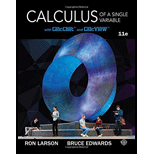
(a)
To graph: The function for the velocity of the object when the air resistance is neglected where an object is thrown upwards at a velocity of 500 feet per second.
(b)
To calculate: The position function of the object and the maximum height it attainswhere an object is thrown upwards at a velocity of 500 feet per second.
(c)
To calculate: The velocity function when air resistance is factored in and the equation is
(d)
To graph: The velocity function obtained in part (c) with the value of k as 0.001 and to determine the time at which the maximum height is obtained.
(e)
To calculate: The approximate value of the integral
(f)
The reason behind the results in parts (b) and (c), the effect of air resistance on the maximum height.
Want to see the full answer?
Check out a sample textbook solution
Chapter 5 Solutions
Calculus of a Single Variable
- Please focus on ix.arrow_forwardPlease focus on vi.arrow_forward的 v If A is an n x n matrix that is not invertible, then A. rank(A) = n C. det(A) = 0 B. Reduced row-echelon form of A = In D. AB BA= In for some matrix B 63°F Partly sunny Q Search 3 $ 4 40 FS 96 S W E A S T FG S Y & コ B ㅁ F G H J 4 Z X C V B N M 9 H V FIB - FIB ㅁ P L ว DELETE BACHSPACE LOCK L ? PAUSE ALT CTRL ENTER 7 2:20 PM 4/14/2025 HOME J INSERT SHIFT END 5arrow_forward
- i Compute the given determinant by cofactor expansions. At each step, choose a row or columnthat involves the least amount of computation.7 6 8 40 0 0 68 7 9 30 4 0 5arrow_forwardi Compute the inverse of the matrix below using row operations. Please show your work.1 0 −2−3 1 42 −3 4 This is a 3*3 matrix. First row is 1 0 -2.arrow_forwardSolve the system of equations below by applying row operations on the corresponding aug-mented matrix to convert it to the reduced row-echelon form. Write the solutions using freevariables as parameters.x1 + 3x2 + x3 = 1−4x1 − 9x2 + 2x3 = −1−3x2 − 6x3 = −3arrow_forward
- Algebra & Trigonometry with Analytic GeometryAlgebraISBN:9781133382119Author:SwokowskiPublisher:Cengage
